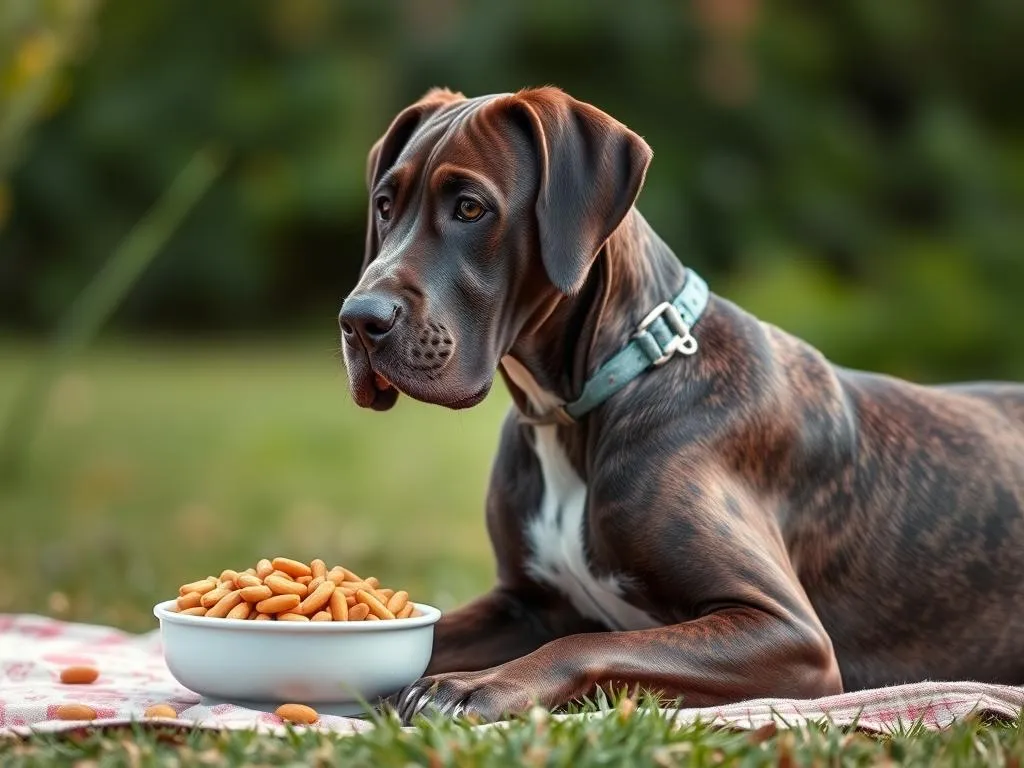
Introduction
Proper nutrition is critical for maintaining the health and longevity of dogs. It can determine everything from energy levels to the quality of their coat and even their overall behavior. For Great Danes, a breed known for its impressive size and gentle temperament, the importance of proper nutrition cannot be overstated. These gentle giants have unique nutritional needs that evolve significantly as they grow from playful puppies into majestic adults.
Understanding when to switch a Great Dane from puppy to adult food is essential for fostering optimal growth and health. This transition is not just about changing the type of food but also ensuring that your dog receives the right nutrients at the right time to support their development.
Understanding Great Dane Growth Stages
Early Development (0-3 Months)
During the first few weeks of life, Great Danes rely on their mother’s milk for essential nutrients. If the mother is not available, high-quality puppy milk replacers may be necessary. Around the age of 4 weeks, you can begin introducing high-quality puppy food, which is specifically formulated to support rapid growth. This food should be rich in protein and fat to aid in muscle development and energy.
Adolescence (4-12 Months)
As your Great Dane enters adolescence, typically between 4 to 12 months, they will experience significant growth spurts. This period is crucial for their development, and their dietary needs will increase. It is recommended to feed them several smaller meals throughout the day rather than one or two larger meals. This feeding schedule supports digestion and helps prevent bloating, a condition to which Great Danes are particularly susceptible.
During this stage, monitoring their weight and adjusting portions based on their growth rates is vital. A balance between protein, fat, and carbohydrates is essential to support their active lifestyle and growing bodies.
Young Adult (1 Year and Beyond)
Once your Great Dane reaches one year of age, it’s time to consider transitioning to adult food. Adult dog food contains different nutritional profiles than puppy food, which is designed for growth. Adult food generally has lower levels of protein and fat, as the growth rate slows significantly. Transitioning to adult food is an important step in ensuring your dog maintains optimal health without the risk of obesity or other health issues.
Key Factors in Determining the Right Time to Switch
Age Considerations
The typical age range for transitioning a Great Dane from puppy to adult food is between 12 to 24 months. However, the exact timing can vary based on individual growth rates and developmental milestones. Signs that your Great Dane may be ready for the switch include reaching adult height, a slowing of the growth rate, and a noticeable decrease in appetite for puppy food.
Weight and Size
Monitoring your Great Dane’s weight is crucial as they approach adulthood. Ideal weight benchmarks for Great Danes vary, but generally, males should weigh between 140 to 175 pounds, while females should weigh between 110 to 145 pounds. If your dog is nearing these benchmarks and shows signs of maturity, it may be time to start considering the transition.
Activity Level
A Great Dane’s activity level can greatly influence their nutritional needs. Active dogs who engage in regular exercise may require more calories and nutrients than those with a more sedentary lifestyle. Adjusting food based on lifestyle and energy expenditure is essential. Puppies that are particularly active may require a higher quantity of puppy food until they transition to adult food.
Health Considerations
Great Danes are prone to certain health issues, including hip dysplasia, heart problems, and obesity. These conditions can be significantly influenced by diet. Consult your veterinarian for personalized advice on when to switch to adult food and what specific dietary needs your dog may have, particularly if they exhibit any health concerns.
Nutritional Needs of Adult Great Danes
Protein and Fat Requirements
Adult Great Danes have different protein and fat requirements compared to puppies. Generally, adult dog food should contain about 18-25% protein and 8-15% fat. These levels support muscle maintenance and overall health without the excess calories that can lead to obesity.
Vitamins and Minerals
Adult Great Danes require a range of vitamins and minerals to maintain their health. Essential nutrients like calcium, phosphorus, and omega fatty acids play critical roles in bone health and coat quality. A balanced diet is crucial for preventing deficiencies and ensuring your dog thrives.
Avoiding Common Nutritional Mistakes
Transitioning from puppy to adult food is not without its pitfalls. Common mistakes include abruptly switching foods, which can lead to digestive upset, or choosing low-quality adult food that lacks essential nutrients. Foods to avoid during the transition include those high in fillers or artificial additives. Recognizing signs of dietary deficiencies or imbalances, such as lethargy, poor coat condition, or gastrointestinal issues, is vital for maintaining your dog’s health.
How to Transition from Puppy to Adult Food
Gradual Transition Process
A gradual transition is key to preventing digestive issues. Start by mixing a small amount of adult food with your puppy’s current food. Gradually increase the proportion of adult food over a week or two. A suggested timeline might look like this:
- Days 1-3: 25% adult food, 75% puppy food
- Days 4-6: 50% adult food, 50% puppy food
- Days 7-10: 75% adult food, 25% puppy food
- Day 11 and beyond: 100% adult food
Monitoring Your Dog’s Response
As you transition, closely monitor your dog’s response to the new food. Signs of successful adaptation include consistent energy levels, normal stool consistency, and an overall positive demeanor. If you notice any adverse reactions, such as diarrhea, vomiting, or lack of appetite, consult your veterinarian for advice.
Adjusting Portions and Feeding Schedule
As your Great Dane grows, their calorie needs will change. Adjusting portions based on age, weight, and activity level is crucial. Maintaining a consistent feeding routine helps manage their hunger and digestion effectively. It is generally recommended to feed adult Great Danes two meals a day to prevent bloat.
Common FAQs About Switching Dog Food
What if My Great Dane Doesn’t Like Adult Food?
If your Great Dane is reluctant to accept adult food, there are several strategies to encourage acceptance. Mixing in a small amount of their favorite treats or adding low-sodium broth can enhance the flavor. Gradually increasing the amount of adult food while decreasing puppy food can help them adjust. If your dog refuses to eat, it may be worth exploring different brands or formulations.
Can I Switch Before 12 Months?
While some dogs may be ready to switch earlier, it’s generally advisable to wait until at least 12 months. Premature switching can lead to nutritional imbalances, particularly in large breed dogs like Great Danes. If you have concerns about your dog’s weight or growth, consult your veterinarian for tailored advice.
How to Choose the Right Adult Dog Food
Selecting high-quality adult dog food is crucial for your Great Dane’s health. Look for foods that list a high-quality protein source as the first ingredient, and ensure the food meets AAFCO (Association of American Feed Control Officials) standards. Recommended brands often include options that are specifically formulated for large breeds. Always read labels carefully to ensure a balanced nutritional profile.
Conclusion
Transitioning your Great Dane from puppy to adult food is a significant step in their growth journey. Doing so at the right time and with careful consideration of their dietary needs can set the stage for a happy, healthy adulthood. Prioritizing your Great Dane’s nutritional requirements will pay dividends in their energy, health, and overall quality of life. As they age, continuous monitoring and adjustments will ensure they remain the vibrant and loving companions we cherish.









